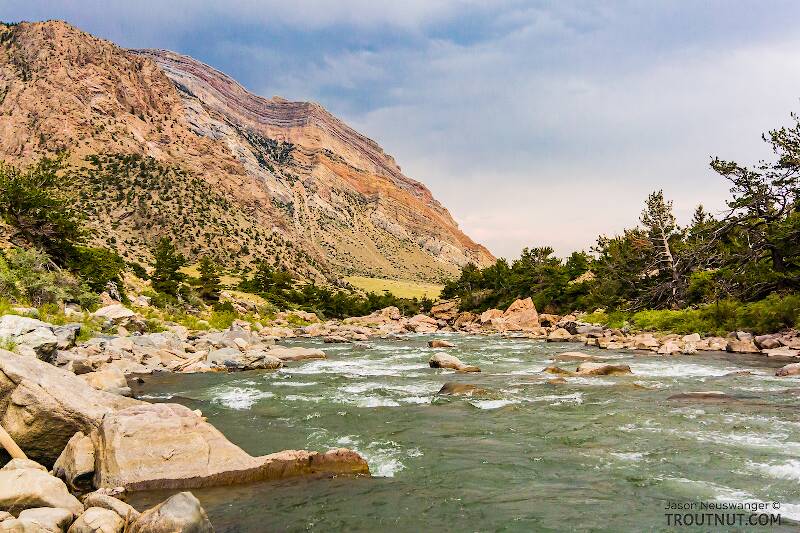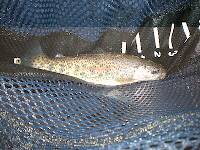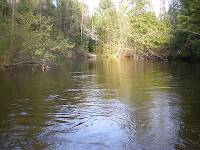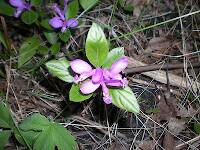
Salmonflies
Pteronarcys californica
The giant Salmonflies of the Western mountains are legendary for their proclivity to elicit consistent dry-fly action and ferocious strikes.
Featured on the forum

It's only barely visible in one of my pictures, but I confirmed under the microscope that this one has a prosternal horn and the antennae are mid-way between the eyes and front of the head capsule.
I'm calling this one Pycnopsyche, but it's a bit perplexing. It seems to key definitively to at least Couplet 8 of the Key to Genera of Limnephilidae Larvae. That narrows it down to three genera, and the case seems wrong for the other two. The case looks right for Pycnopsyche, and it fits one of the key characteristics: "Abdominal sternum II without chloride epithelium and abdominal segment IX with only single seta on each side of dorsal sclerite." However, the characteristic "metanotal sa1 sclerites not fused, although often contiguous" does not seem to fit well. Those sclerites sure look fused to me, although I can make out a thin groove in the touching halves in the anterior half under the microscope. Perhaps this is a regional variation.
The only species of Pycnopsyche documented in Washington state is Pycnopsyche guttifera, and the colors and markings around the head of this specimen seem to match very well a specimen of that species from Massachusetts on Bugguide. So I am placing it in that species for now.
Whatever species this is, I photographed another specimen of seemingly the same species from the same spot a couple months later.
I'm calling this one Pycnopsyche, but it's a bit perplexing. It seems to key definitively to at least Couplet 8 of the Key to Genera of Limnephilidae Larvae. That narrows it down to three genera, and the case seems wrong for the other two. The case looks right for Pycnopsyche, and it fits one of the key characteristics: "Abdominal sternum II without chloride epithelium and abdominal segment IX with only single seta on each side of dorsal sclerite." However, the characteristic "metanotal sa1 sclerites not fused, although often contiguous" does not seem to fit well. Those sclerites sure look fused to me, although I can make out a thin groove in the touching halves in the anterior half under the microscope. Perhaps this is a regional variation.
The only species of Pycnopsyche documented in Washington state is Pycnopsyche guttifera, and the colors and markings around the head of this specimen seem to match very well a specimen of that species from Massachusetts on Bugguide. So I am placing it in that species for now.
Whatever species this is, I photographed another specimen of seemingly the same species from the same spot a couple months later.

Troutnut is a project started in 2003 by salmonid ecologist Jason "Troutnut" Neuswanger to help anglers and
fly tyers unabashedly embrace the entomological side of the sport. Learn more about Troutnut or
support the project for an enhanced experience here.
Wbranch on Jan 25, 2015January 25th, 2015, 6:16 am EST
Okay I've heard of them but not exactly sure what it is and are they truly an aid to more hookups or just another fly tying gimmick? I'm assuming they are a brightly colored bead, or band of tying thread, in hot red, orange, or chartreuse that a trout sees first in the water then comes over and eats the nymph. Has anyone done any real comparison to see if the hot spot fly catches more trout than a fly without the hot spot.
Catskill fly fisher for fifty-five years.
Troutnut on Jan 25, 2015January 25th, 2015, 7:58 am EST
I found an article on flytyer.com showing several "hot spot" flies. Some of the flies remind me of a local Wisconsin pattern, the pink squirrel nymph, which is my all-time favorite subsurface attractor fly.
I haven't done a side-by-side comparison, but I can guess at why it works well. We have two jobs as fly anglers: 1) get the fish to see the fly, and 2) get the fish to take the fly when it sees it. The hotspot surely aids in job 1. For job 2, keep in mind that the question a fish is usually asking itself when it sees a fly is not "is this food or an artificial lure?" but "is this food or debris?" We try to use flies with features, like overall shape, movement, and translucency, that are often found in real insects but rarely in little pieces of twigs or grass or other debris in the drift.
One of those features that's fairly rare in debris, I think, is a sharp transition between two contrasting colors. We see it a lot on real insects, for both camouflage reasons and coincidental reasons (like black wingpads on a ready-to-emerge nymph, or the contrast between the head/body and case of a caddis larva).
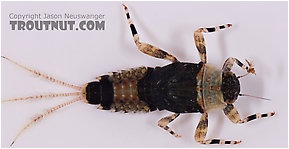
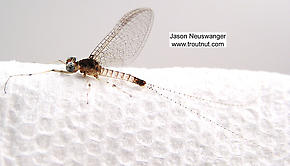
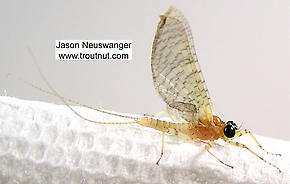
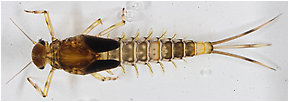
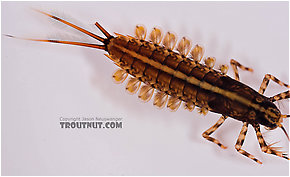
I think regardless of which colors/shades are involved, a sharp contrast between light and dark is a lifelike feature that helps the fish separate prey from debris. And I think when fish aren't being selective to a single hatch, they're mainly looking for any combination of lifelike features as a positive trigger to indicate that something is food, or at least likely enough to be food that it's worth grabbing and then spitting out if it's not (they do this all the time with real debris, and aren't thinking about hooks).
So the "hotspot" almost certainly helps the fish notice the fly, and is probably more likely to help than hurt when a non-selective fish is deciding whether to take the fly. I'd say it's worth keeping a few in your box.
I haven't done a side-by-side comparison, but I can guess at why it works well. We have two jobs as fly anglers: 1) get the fish to see the fly, and 2) get the fish to take the fly when it sees it. The hotspot surely aids in job 1. For job 2, keep in mind that the question a fish is usually asking itself when it sees a fly is not "is this food or an artificial lure?" but "is this food or debris?" We try to use flies with features, like overall shape, movement, and translucency, that are often found in real insects but rarely in little pieces of twigs or grass or other debris in the drift.
One of those features that's fairly rare in debris, I think, is a sharp transition between two contrasting colors. We see it a lot on real insects, for both camouflage reasons and coincidental reasons (like black wingpads on a ready-to-emerge nymph, or the contrast between the head/body and case of a caddis larva).





I think regardless of which colors/shades are involved, a sharp contrast between light and dark is a lifelike feature that helps the fish separate prey from debris. And I think when fish aren't being selective to a single hatch, they're mainly looking for any combination of lifelike features as a positive trigger to indicate that something is food, or at least likely enough to be food that it's worth grabbing and then spitting out if it's not (they do this all the time with real debris, and aren't thinking about hooks).
So the "hotspot" almost certainly helps the fish notice the fly, and is probably more likely to help than hurt when a non-selective fish is deciding whether to take the fly. I'd say it's worth keeping a few in your box.
Jason Neuswanger, Ph.D.
Troutnut and salmonid ecologist
Troutnut and salmonid ecologist
Entoman on Jan 25, 2015January 25th, 2015, 8:00 am EST
Hmm, good question Matt. Never thought about it much but I do have a few patterns tied that way that I wouldn't change for the world. I don't know if the hotspot is the reason for their success or not, but I wouldn't feel as confident without them.
A few that come to mind:
Hale Bop Leech (olive fly with fl. flame thread band behind bead)
Salmonfly nymphs and dries (fl. Flame band at head)
Western green drake nymphs and dries (fl. Chartreuse band behind head or bead)
Peacock bodied black foam beetle with a fl. Chartreuse butt. I tie this fly with a few strands of crystal flash sticking up to simulate a disheveled underwing but mostly to assist in seeing the damned thing. :) - A real killer on many lakes and ponds in the Summer!
A few that come to mind:
Hale Bop Leech (olive fly with fl. flame thread band behind bead)
Salmonfly nymphs and dries (fl. Flame band at head)
Western green drake nymphs and dries (fl. Chartreuse band behind head or bead)
Peacock bodied black foam beetle with a fl. Chartreuse butt. I tie this fly with a few strands of crystal flash sticking up to simulate a disheveled underwing but mostly to assist in seeing the damned thing. :) - A real killer on many lakes and ponds in the Summer!
"It's not that I find fishing so important, it's just that I find all other endeavors of Man equally unimportant... And not nearly as much fun!" Robert Traver, Anatomy of a Fisherman
Oldredbarn on Jan 25, 2015January 25th, 2015, 1:47 pm EST
Good stuff boys! Rather thoughtful of you there Jason...Its nice to see you are still paying attention from up there...Maybe you are thinking about some little favorite trout filled stream in the lower 48 you have been missing a bit. :)
I'm gonna tie up a dozen of them pink squirrels in your honor.
Spence
I'm gonna tie up a dozen of them pink squirrels in your honor.
Spence
"Even when my best efforts fail it's a satisfying challenge, and that, after all, is the essence of fly fishing." -Chauncy Lively
"Envy not the man who lives beside the river, but the man the river flows through." Joseph T Heywood
"Envy not the man who lives beside the river, but the man the river flows through." Joseph T Heywood
Entoman on Jan 25, 2015January 25th, 2015, 8:04 pm EST
Thinking the same thing, Spence. You and I have such a small collection of flies so what harm can there be in adding another one. :)
Jason -
I'm surprised you didn't mention one of your favorite series of dry attractors! The name isn't coming to mind but I seem to remember you extolling the virtues of one of LaFontaine's creations where the design criteria was to frame a hot spot of specific color that would vary dependent on lighting conditions.
Jason -
I'm surprised you didn't mention one of your favorite series of dry attractors! The name isn't coming to mind but I seem to remember you extolling the virtues of one of LaFontaine's creations where the design criteria was to frame a hot spot of specific color that would vary dependent on lighting conditions.
"It's not that I find fishing so important, it's just that I find all other endeavors of Man equally unimportant... And not nearly as much fun!" Robert Traver, Anatomy of a Fisherman
Planettrout on Jan 26, 2015January 26th, 2015, 6:29 am EST
I use a lot of nymph and bugger patterns with hot spots.Most often I use Datum Glo-Brite floss for the spot:
http://www.caddisflyshop.com/glo-brite-floss.html
I file them under the category of attractors...this one, The Buffalo Jump, has taken a lot of nice Browns and Bows for me here in the Eastern Sierras...
< />
< />
...and this pattern from Al & Gretchen, using thread, floss or wire on the bend has taken numerous large Browns on the Madison just after run-off:
http://www.flytierspage.com/agbeatty/bh_renegade_wet.htm
PT/TB
http://www.caddisflyshop.com/glo-brite-floss.html
I file them under the category of attractors...this one, The Buffalo Jump, has taken a lot of nice Browns and Bows for me here in the Eastern Sierras...
< />

< />

...and this pattern from Al & Gretchen, using thread, floss or wire on the bend has taken numerous large Browns on the Madison just after run-off:
http://www.flytierspage.com/agbeatty/bh_renegade_wet.htm
PT/TB
Daughter to Father: "How many arms do you have, how many fly rods do you need?"
http://planettrout.wordpress.com/
http://planettrout.wordpress.com/
Troutnut on Jan 26, 2015January 26th, 2015, 10:53 am EST
Jason -
I'm surprised you didn't mention one of your favorite series of dry attractors! The name isn't coming to mind but I seem to remember you extolling the virtues of one of LaFontaine's creations where the design criteria was to frame a hot spot of specific color that would vary dependent on lighting conditions.
I interpreted the original question to be more about nymphs, but yes the principle certainly applies to attractor dries, too!
Jason Neuswanger, Ph.D.
Troutnut and salmonid ecologist
Troutnut and salmonid ecologist
Oldredbarn on Jan 26, 2015January 26th, 2015, 11:27 am EST
Thinking the same thing, Spence. You and I have such a small collection of flies so what harm can there be in adding another one. :)
Ha! Beadheads to boot! Please Lord don't ever let Kurt, or Spence, or Rene Harrop, ever fall over in a stream..."So long. Been good to know you." :)
Spence
"Even when my best efforts fail it's a satisfying challenge, and that, after all, is the essence of fly fishing." -Chauncy Lively
"Envy not the man who lives beside the river, but the man the river flows through." Joseph T Heywood
"Envy not the man who lives beside the river, but the man the river flows through." Joseph T Heywood
PaulRoberts on Jan 26, 2015January 26th, 2015, 3:16 pm EST
Good explanation, Jason.
Quick Reply
Related Discussions
Topic
Replies
Last Reply
4
Mar 11, 2012
by Entoman
by Entoman
7
Apr 1, 2009
by Troutnut
by Troutnut
4
May 24, 2011
by Jmd123
by Jmd123

